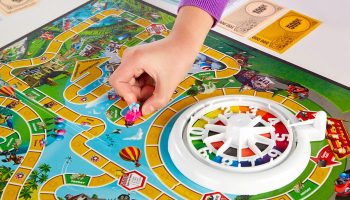Ravensburger’s Christine Meier and Alexander Loehr discuss the development of Play+

Guys, it’s great to catch up. For anyone new to Play+, how would you describe it? Why is this an exciting range for Ravensburger?
Alexander Loehr, International Category Director, Infant/Toddler, Ravensburger: It’s exciting for us because it’s the first time we’re showing this range internationally. The range takes a holistic approach to early childhood development and spans a wide mix of products, materials and technologies – 30 items across books and toys.
A big range. And one you developed the range alongside child experts. How did that collaboration work?
Alexander: We took time to research and speak to experts – like paediatricians and nursery professionals – in different countries. We also interviewed parents in the UK. The insights gathered formed the foundation of what the needs of a child are and what our priorities should be when it came to product.
We then started developing the line with those responses firmly in mind. Throughout the process it’s been a consumer-first approach, which you’d presume is normal, but the toy industry can often work based on traditional ideas. We wanted to start entirely from scratch, grounding every aspect of the range in the insights gleaned from research. In this way, we have created a line that not only addresses the needs of children in those very early years, but also integrates practical features that parents called for too.
I’m really proud of what the team has achieved… We created everything in-house – from design to illustrations. This process will add to the knowledge base for Ravensburger and offer experience that will be instrumental in future product developments.

Absolutely. You mentioned that you’re now taking the range to international markets. Do different territories require different things from a collection like this?
Alexander: In this age group, the zero to three-year-olds, there’s a natural development of children across stages… That is triggered in very similar ways, regardless of where you are in the world. Things like fine motor skills or shape sorting are universal concepts. One area where we have historically seen some differences is in the books, particularly the illustrations. The German audience has often had a slightly different taste to other countries, and it was interesting to compare the responses from parents in our research.
Christine Meier, Team Lead Editorial, Infant & Toddler Books, Ravensburger: Yes, on the artwork side, we’ve seen some changes. It used to be the case that Germany had its own very defined tastes, but more recently we’re seeing Germany align more with the UK than it has done in previous years. For us, it meant we can have a uniformed look in the illustrations across the Play+ range. Outside of the illustration side, concepts like sliders, flaps, touch and feel are all well-known systems in books for young children internationally.
Alexander: The biggest compliment we got was when we were told the illustration style would also be suitable for the UK. As Christine said, usually German illustrations are very different in style!
In what way?
Alexander: We would speak about more ‘flat design’. For example, in the UK, our experience is that the audience prefers animals that are simplified, with their eyes exaggerated and bigger – and looking at you in a more engaging way. But in Germany, book illustrations are more traditional in the depiction of things and in the colours chosen.

Interesting. And how do you approach innovating in a sector like pre-school books? I’d imagine it’s an area grounded in tradition.
Christine: We have the benefit of drawing upon a lot of experience in this area. Ravensburger is the number one board book publisher in the Germany. In our experience, we realise that not all game or play concepts translate to their best in the context of a book. Take a memory game for example… If you put a memory game element into the context of a book, you might find it works better as a pure memory game.
In the development process for Play+ we always tried to think about what makes sense and adds play value in the best possible way – and we’ve got some great concepts. Not all game or play concepts translate well to the context of a book.
Alexander: The ‘toyification’ of books was very important for us, even at the concept stage. It has to work as a plaything for a very young child, and also have the storytelling and education pull for that child when they get a little older. In this way, it’s like they’re rediscovering the book.
Were there any key design challenges around this range?
Alexander: This age group was new for the company, so we’ve had to build a design language from scratch for Ravensburger. It had to make sense in the context of the company’s legacy and history, as well as suiting our global ambitions for the range.
On that, you’ve had several recent success stories – like Disney Lorcana – that are well and truly global hits. Is there a healthy tension between retaining the tradition and sensibilities of the German company, and your current global outlook and ambitions?
Alexander: Whether you’re a traditional German company or a traditional British company or a traditional US company, everyone is going through a massive transformation at the moment. For me, this international exposure is inspiring. We believe these global launches and different points of view make us stronger and more relevant. We’re also seeing a huge cultural transition in Germany as well – and there are changes happening – but we see collaboration with our global teams as the fun part of our work.
It’s also a strength to have such a strong base in Germany. Having these long-standing traditions means we’re open to trying new things. There’s a sense of stability that allows us to focus on what we want to do and put fresh innovations through a tried and tested system that ensures we have a strong product. It’s a healthy balance.
Guys, this has been great. To wrap up, is there one item in the range that you feel highlights what makes Play+ special?
Alexander: That’s a tricky one there are just too many to choose from! The Flip & Pop books are great – featuring a silicone edge for teething. They’re good for parents on the go, with untearable pages and are easily washable. They’re very convenient and come in handy when parents are under pressure to pack the baby bag and get on the move. You’ve got something like that, right the way through to our 4-in-1 Colour and Shape Sorter Chameleon toy which is packed with play features and boasts layered complexity to grow with the child.
Great picks. Thanks again and good luck with Play+ moving forward.
–
To stay in the loop with the latest news, interviews and features from the world of toy and game design, sign up to our weekly newsletter here



























